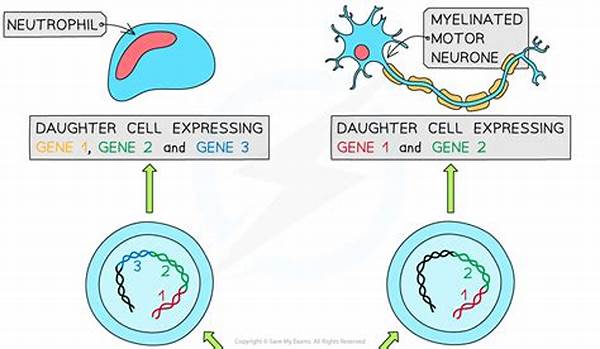Understanding the molecular mechanisms underlying cellular differentiation is pivotal to the advancement of developmental biology and regenerative medicine. At the core of this biological process lies gene expression, a complex orchestration of transcriptional and post-transcriptional events, wherein genes are selectively activated or repressed. This article delves into the nuances of gene expression during differentiation, emphasizing the critical role it plays in the specialization of cells.
Read Now : Natural Medicine For Anxiety Relief
The Role of Gene Expression in Cellular Differentiation
Gene expression during differentiation is a meticulously regulated process that ensures the proper development and function of diverse cell types. Differentiation entails the transformation of a relatively unspecialized cell, such as a stem cell, into a specialized cell type with distinct functions. During this process, specific genes are either upregulated or downregulated, a phenomenon directed by transcription factors and epigenetic modifications. The dynamic nature of gene expression during differentiation allows progenitor cells to acquire unique phenotypes requisite for their specialized roles within tissues. Furthermore, the interplay between signaling pathways and transcriptional regulators orchestrates this gene expression landscape, influencing cellular fate decisions. Thus, elucidating the mechanisms of gene expression during differentiation not only enhances our understanding of developmental biology but also informs therapeutic strategies for regenerative medicine.
Mechanisms Influencing Gene Expression During Differentiation
1. Epigenetic Modifications
Gene expression during differentiation is influenced by epigenetic modifications, such as DNA methylation and histone acetylation. These changes contribute to the activation or repression of specific gene sets, determining cellular identities.
2. Transcription Factor Dynamics
The binding of transcription factors to DNA regulatory regions is crucial for gene expression during differentiation, influencing which genes are expressed or silenced as cells assume new identities.
3. Non-coding RNAs
Non-coding RNAs, including microRNAs and long non-coding RNAs, regulate gene expression during differentiation by modulating mRNA stability and translation, thus fine-tuning cellular differentiation processes.
4. Cell Signaling Pathways
Signaling pathways such as Wnt, Notch, and Hedgehog play a significant role in controlling gene expression during differentiation, guiding cells through various stages of development by influencing transcriptional activity.
Read Now : Epigenetic Modifications During Cell Lineage Specification
5. Chromatin Remodeling
Alterations in chromatin structure through remodeling complexes affect gene expression during differentiation, facilitating or hindering the access of transcriptional machinery to DNA.
Implications of Gene Expression Regulation in Stem Cell Differentiation
The regulatory networks of gene expression during differentiation in stem cells prove integral to developmental processes and regenerative medicine applications. In stem cells, the regulation is pivotal in transitioning cells from a pluripotent state to a differentiated state, where they acquire specialized functions. The intricate orchestration of gene activation and repression allows stem cells to give rise to diverse lineages and various cell types necessary for tissue formation and repair. Understanding these regulatory networks enables researchers to manipulate conditions in vitro, allowing for the directed differentiation of stem cells into specific cell types, a key aspect in tissue engineering and regenerative therapies. Comprehending the molecular basis of gene expression during differentiation also aids in identifying potential targets for correcting developmental disorders and enhancing repair mechanisms in degenerative diseases, illustrating its profound impact on medical science.
Advances in Research on Gene Expression During Differentiation
Research advancements in gene expression during differentiation continue to unravel the complexities inherent in cellular development. Recent studies have highlighted the significance of three-dimensional genomic architecture in influencing gene accessibility and expression patterns. Moreover, cutting-edge technologies such as single-cell RNA sequencing have enabled detailed analysis of gene expression profiles, revealing heterogeneity within cell populations during differentiation. These insights underscore the necessity of investigating how spatial and temporal dynamics of gene regulation contribute to the fidelity of cell fate decisions. Such knowledge will not only deepen our understanding of fundamental biological principles but will also pave the way for innovative therapeutic approaches to control and harness differentiation processes in medical applications.
Genetic and Epigenetic Regulation of Differentiation
Chromatin Architecture’s Impact on Gene Expression
Gene expression during differentiation is intricately connected to chromatin architecture, as alterations in DNA structure dictate gene accessibility to transcriptional machinery. The dynamic remodeling of chromatin, governed by a repertoire of chromatin modifiers, orchestrates the activation or silencing of genes critical for differentiation. These genomic rearrangements facilitate the establishment of a cellular memory, whereby progenitor cells follow predetermined pathways to achieve specialized functions. Understanding how chromatin remodeling influences gene expression during differentiation is vital for uncovering mechanisms of cellular specialization.
The Epigenetic Landscape and Cellular Identity
The epigenetic landscape, characterized by modifications such as DNA methylation, histone acetylation, and methylation, guides gene expression during differentiation. This landscape is carefully orchestrated by cellular signals and external cues, driving progenitor cells towards lineage-specific identities. Epigenetic changes ensure that once a cell commits to a particular lineage, it maintains its differentiation status and function. These modifications act as molecular switches, facilitating or hindering transcriptional activity, to foster cellular specialization imperative for proper tissue development and function.
Conclusion on Gene Expression During Differentiation
In summary, gene expression during differentiation encompasses the regulation of genetic material and its subsequent translation into proteins that define cellular identity and function. This process is achieved through a complex network of signaling pathways, transcription factors, and epigenetic alterations that comprise regulatory frameworks responsive to both intrinsic programs and extrinsic cues. Understanding these mechanisms provides invaluable insights into developmental biology and regenerative medicine. The ability to manipulate gene expression during differentiation holds promise in devising novel therapeutic strategies for repair and recovery in degenerative diseases and tissue injuries, delineating a path forward for advanced and personalized medical approaches.
